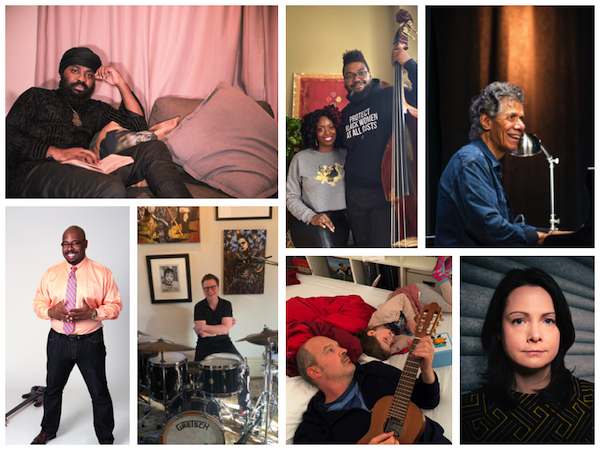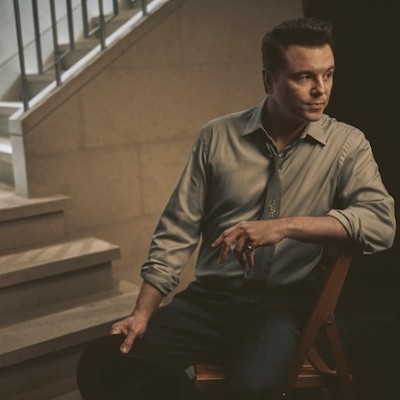Dec 9, 2025 12:28 PM
In Memoriam: Gordon Goodwin, 1954–2025
Gordon Goodwin, an award-winning saxophonist, pianist, bandleader, composer and arranger, died Dec. 8 in Los Angeles.…

Top row from left: Nduduzo Makhathini (Photo: Nailah Makhathini); Brandee Younger and Dezron Douglas at their home in the East Harlem neighborhood of New York City (Photo: Courtesy of Artists); Chick Corea (Photo: Toshi Sakurai, Courtesy Chick Corea Productions). Bottom row from left: Christian McBride (Photo: R. Andrew Lepley); Stanton Moore at his home in New Orleans (Photo: Lauren Del Rio); Wolfgang Muthspiel and his 4-year-old daughter, Flora, at their home in Vienna (Photo: Courtesy of Artist); Kris Davis (Photo: ©Caroline Mardok).
(Photo: DownBeat Collage)“It’s scary in that we don’t know when we’re going to be able to go back to work,” the drummer continued. “It’s a little scarier, too, because of the unknown. Katrina happened and then it was over: ‘OK, let’s start rebuilding.’ This, it’s still happening, and we don’t know how bad it’s gonna get.”
Although the club received Paycheck Protection Program funds on May 1, Moore said the venue is on uncertain footing. And by mid-May, the Tipitina’s website included ways for fans to make donations directly to the club.
Disasters and tragedies bind humanity together, and few things resonate emotionally in the same way as 9/11. Americans might not live side-by-side in harmony, but chaos, fear and anger only rarely wash over the entire population all at once.
“Having lived through 9/11 and this, this is unlike anything else because the entire world was not affected by 9/11,” bassist McBride said from his Montclair, New Jersey, office in April. “There were certain areas of the country—and the world—that went right on about their business ... . During 9/11, if you wanted to leave New York and go to Kansas, you’d be fine, right? But that’s not the case now.”
As one of the most visible figures of the genre—leading his own ensembles, performing in groups led by Corea and Joshua Redman, hosting the radio show Jazz Night in America, serving as the Newport Jazz Festival’s artistic director, and acting as artistic chair for the jazz education organization Jazz House Kids—McBride occupies a unique place in the music.
He’s also served as a de facto talent scout while playing at clubs and festivals over the years. But that role has been rendered ineffective during the pandemic.
“The truth of the matter is, scouting people means that you see them play at a jazz festival—or the word of mouth is always the best way,” McBride said. “No matter how much technology has progressed over the years, when some musician you respect or trust says, ‘Hey man, you should check out such and such a person,’ that tends to go a long way, more so than searching someone out online. ... You want to see them live, and you want to feel them in the raw. So, the YouTube clip or whatever they do online, that’s only the introduction.”
The pandemic also threatens to put on hold the hopes of a generation of emerging performers—and stifle momentum that mid-career players have been amassing. And while some artists are easily inspired to find ways to create something vibrant during a time when we’re all fearful of getting too close to strangers at the grocery store, others simply aren’t wired that way. McBride, though, expressed confidence in the internal lives of the creative class.
“That’s really all you can do—you have to go into your creative pool,” he said. “I mean, there really is no excuse not to tap into that creative pool or different ways of finding creative expression. That’s all we have—time to practice and write. So, creatively, I predict some real amazing things are going to come out of this crisis.”
There already have been a few notable expressions of creative perseverance, works that defy the narrowing experience of the lockdown. Multi-instrumentalist Nicholas Payton has been particularly busy, releasing Quarantined With Nick and Maestro Rhythm King—which he indicated was about 60 percent complete prior to the spring.
During a Zoom interview, pianist Nduduzo Makhathini paused and asked his kids to give him a minute, as he chatted from the bedroom of the East London, South Africa, home he shares with his wife, daughter and two sons.
In April, he seemed upbeat, having just completed a pair of streaming performances to celebrate the release of his Blue Note debut, Modes Of Communication: Letters From The Underworlds.

Goodwin was one of the most acclaimed, successful and influential jazz musicians of his generation.
Dec 9, 2025 12:28 PM
Gordon Goodwin, an award-winning saxophonist, pianist, bandleader, composer and arranger, died Dec. 8 in Los Angeles.…

Flea has returned to his first instrument — the trumpet — and assembled a dream band of jazz musicians to record a new album.
Dec 2, 2025 2:01 AM
After a nearly five-decade career as one of his generation’s defining rock bassists, Flea has returned to his first…

“It’s a pleasure and an honor to interpret the music of Oscar Peterson in his native city,” said Jim Doxas in regard to celebrating the Canadian legend. “He traveled the world, but never forgot Montreal.”
Nov 18, 2025 12:16 PM
In the pantheon of jazz luminaries, few shine as brightly, or swing as hard, as Oscar Peterson. A century ago, a…

Dec 11, 2025 11:00 AM
DownBeat presents a complete list of the 4-, 4½- and 5-star albums from 2025 in one convenient package. It’s a great…

Seth MacFarlane takes a turn from his television and film career to sing arrangements made for Frank Sinatra, but never recorded.
Nov 18, 2025 12:04 PM
“I’m not gonna lie to you — I don’t know why I thought this was about The Naked Gun, but I’m happy it’s…